Laboratory
A laboratory (UK: /ləˈbɒrətəri/, US: /ˈlæbərətɔːri/; colloquially lab) is a facility that provides controlled conditions in which scientific or technological research, experiments, and measurement may be performed. Laboratory services are provided in a variety of settings: physicians offices, clinics, hospitals, and regional and national referral centers.[1]
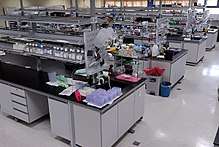
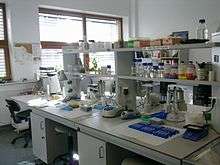

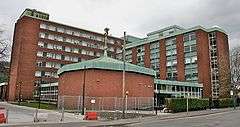
Overview
Laboratories used for scientific research take many forms because of the differing requirements of specialists in the various fields of science and engineering. A physics laboratory might contain a particle accelerator or vacuum chamber, while a metallurgy laboratory could have apparatus for casting or refining metals or for testing their strength. A chemist or biologist might use a wet laboratory, while a psychologist's laboratory might be a room with one-way mirrors and hidden cameras in which to observe behavior. In some laboratories, such as those commonly used by computer scientists, computers (sometimes supercomputers) are used for either simulations or the analysis of data. Scientists in other fields will use still other types of laboratories. Engineers use laboratories as well to design, build, and test technological devices.
Scientific laboratories can be found as research room and learning spaces in schools and universities, industry, government, or military facilities, and even aboard ships and spacecraft.
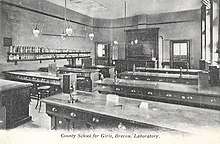
Despite the underlying notion of the lab as a confined space for experts,[2] the term "laboratory" is also increasingly applied to workshop spaces such as Living Labs, Fab Labs, or Hackerspaces, in which people meet to work on societal problems or make prototypes, working collaboratively or sharing resources.[3][4][5] This development is inspired by new, participatory approaches to science and innovation and relies on user-centred design methods[6] and concepts like Open innovation or User innovation,.[7][8] One distinctive feature of work in Open Labs is phenomena of translation, driven by the different backgrounds and levels of expertise of the people involved.[9]
History
Early instances of "laboratories" recorded in English involved alchemy and the preparation of medicines.[10]
The emergence of Big Science during World War II increased the size of laboratories and scientific equipment, introducing particle accelerators and similar devices.
The early laboratories
The earliest laboratory according to the present evidence is a home laboratory of Pythagoras of Samos, the well-known Greek philosopher and scientist. This laboratory was created when Pythagoras conducted an experiment about tones of sound and vibration of string.[11]
In the painting of Louis Pasteur by Albert Edelfelt in 1885, Louis Pasteur is shown comparing a note in his left hand with a bottle filled with a solid in his right hand, and not wearing any personal protective equipment.[12]
Researching in teams started in the 19th century, and many new kinds of equipment were developed in the 20th century.[13]
A 16th century underground alchemical laboratory was accidentally discovered in the year 2002. Rudolf II, Holy Roman Emperor was believed to be the owner. The laboratory is called Speculum Alchemiae and is preserved as a museum in Prague.[14]
 Chemistry laboratory of the 18th century, of the sort used by Antoine Lavoisier and his contemporaries
Chemistry laboratory of the 18th century, of the sort used by Antoine Lavoisier and his contemporaries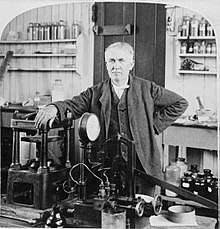 Thomas Edison in his laboratory, 1901
Thomas Edison in his laboratory, 1901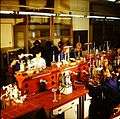 A laboratory in the 1970s
A laboratory in the 1970s Chemical laboratory in Mahidol University International College since 2009
Chemical laboratory in Mahidol University International College since 2009 Early 2000s style of counter in Chemical Laboratory, Mahidol University International College, Thailand
Early 2000s style of counter in Chemical Laboratory, Mahidol University International College, Thailand Laboratory for organic Chemistry at the University of Applied Science Aachen, Campus Jülich, Germany
Laboratory for organic Chemistry at the University of Applied Science Aachen, Campus Jülich, Germany
Techniques
Laboratory techniques are the set of procedures used on natural sciences such as chemistry, biology, physics to conduct an experiment, all of them follow the scientific method; while some of them involve the use of complex laboratory equipment from laboratory glassware to electrical devices, and others require more specific or expensive supplies.
Equipment and supplies

Laboratory equipment refers to the various tools and equipment used by scientists working in a laboratory:
The classical equipment includes tools such as Bunsen burners and microscopes as well as specialty equipment such as operant conditioning chambers, spectrophotometers and calorimeters.
- Chemical laboratories
- laboratory glassware such as the beaker or reagent bottle
- Analytical devices as HPLC or spectrophotometers
- Molecular biology laboratories + Life science laboratories
- Autoclave
- Microscope
- Centrifuges
- Shakers & mixers
- Pipette
- Thermal cyclers (PCR)
- Photometer
- Refrigerators and Freezers
- Universal testing machine
- ULT Freezers
- Incubators
- Bioreactor
- Biological safety cabinets
- Sequencing instruments
- Fume hoods
- Environmental chamber
- Humidifier
- Weighing scale
- Reagents (supply)
- Pipettes tips (supply)
- Polymer (supply) consumables for small volumes (µL and mL scale), mainly sterile
Laboratory equipment is generally used to either perform an experiment or to take measurements and gather data. Larger or more sophisticated equipment is generally called a scientific instrument.
Specialized types
The title of laboratory is also used for certain other facilities where the processes or equipment used are similar to those in scientific laboratories. These notably include:
- Film laboratory or Darkroom
- Clandestine lab for the production of illegal drugs
- Computer lab
- Crime lab used to process crime scene evidence
- Language laboratory
- Medical laboratory (involves handling of chemical compounds)
- Public health laboratory
- Industrial laboratory
Safety

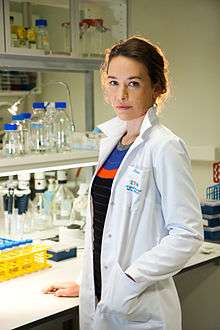
In many laboratories, hazards are present. Laboratory hazards might include poisons; infectious agents; flammable, explosive, or radioactive materials; moving machinery; extreme temperatures; lasers, strong magnetic fields or high voltage. Therefore, safety precautions are vitally important. Rules exist to minimize the individual's risk, and safety equipment is used to protect the lab users from injury or to assist in responding to an emergency.
The Occupational Safety and Health Administration (OSHA) in the United States, recognizing the unique characteristics of the laboratory workplace, has tailored a standard for occupational exposure to hazardous chemicals in laboratories. This standard is often referred to as the "Laboratory Standard". Under this standard, a laboratory is required to produce a Chemical Hygiene Plan (CHP) which addresses the specific hazards found in its location, and its approach to them.
In determining the proper Chemical Hygiene Plan for a particular business or laboratory, it is necessary to understand the requirements of the standard, evaluation of the current safety, health and environmental practices and assessment of the hazards. The CHP must be reviewed annually. Many schools and businesses employ safety, health, and environmental specialists, such as a Chemical Hygiene Officer (CHO) to develop, manage, and evaluate their CHP. Additionally, third party review is also used to provide an objective "outside view" which provides a fresh look at areas and problems that may be taken for granted or overlooked due to habit.
Inspections and audits like also be conducted on a regular basis to assess hazards due to chemical handling and storage, electrical equipment, biohazards, hazardous waste management, chemical waste, housekeeping and emergency preparedness, radiation safety, ventilation as well as respiratory testing and indoor air quality. An important element of such audits is the review of regulatory compliance and the training of individuals who have access to or work in the laboratory. Training is critical to the ongoing safe operation of the laboratory facility. Educators, staff and management must be engaged in working to reduce the likelihood of accidents, injuries and potential litigation. Efforts are made to ensure laboratory safety videos are both relevant and engaging.[15]
Organization
Organization of laboratories is an area of focus in sociology. Scientists consider how their work should be organized, which could be based on themes, teams, projects or fields of expertise. Work is divided, not only between different jobs of the laboratory such as the researchers, engineers and technicians, but also in terms of autonomy (should the work be individual or in groups).[16] For example, one research group has a schedule where they conduct research on their own topic of interest for one day of the week, but for the rest they work on a given group project.[17] Finance management is yet another organizational issue.
The laboratory itself is a historically dated organizational model. It came about due to the observation that the quality of work of researchers who collaborate is overall greater than a researcher working in isolation. From the 1950s, the laboratory has evolved from being an educational tool used by teachers to attract the top students into research, into an organizational model allowing a high level of scientific productivity.
Some forms of organization in laboratories include:
- Their size: Varies from a handful of researches to several hundred.
- The division of labor: "Occurs between designers and operatives; researchers, engineers, and technicians; theoreticians and experimenters; senior researchers, junior researchers and students; those who publish, those who sign the publications and the others; and between specialities." [18]
- The coordination mechanisms: Which includes the formalization of objectives and tasks; the standardization of procedures (protocols, project management, quality management, knowledge management), the validation of publications and cross-cutting activities (number and type of seminars).
There are three main factors that contribute to the organizational form of a laboratory :
- The educational background of the researchers and their socialization process.
- The intellectual process involved in their work, including the type of investigation and equipment they use.
- The laboratory's history.
Other forms of organization include social organization.
Social organization
A study by Richard H.R. Harper, involving two laboratories, will help elucidate the concept of social organization in laboratories. The main subject of the study revolved around the relationship between the staff of a laboratory (researchers, administrators, receptionists, technicians, etc.) and their Locator. A Locator is an employee of a Laboratory who is in charge of knowing where each member of the laboratory currently is, based on a unique signal emitted from the badge of each staff member. The study describes social relationships among different classes of jobs, such as the relationship between researchers and the Locator. It does not describe the social relationship between employees within a class, such as the relationship between researchers.
Through ethnographic studies, one finding is that, among the personnel, each class (researchers, administrators...) has a different degree of entitlement, which varies per laboratory. Entitlement can be both formal or informal (meaning it's not enforced), but each class is aware and conforms to its existence. The degree of entitlement, which is also referred to as a staff's rights, affects social interaction between staff. By looking at the various interactions among staff members, we can determine their social position in the organization. As an example, administrators, in one lab of the study, do not have the right to ask the Locator where the researchers currently are, as they are not entitled to such information. On the other hand, researchers do have access to this type of information. So a consequence of this social hierarchy is that the Locator discloses various degrees of information, based on the staff member and their rights. The Locator does not want to disclose information that could jeopardize his relationship with the members of staff. The Locator adheres to the rights of each class.
Social hierarchy is also related to attitudes towards technologies. This was inferred based on the attitude of various jobs towards their lab badge. Their attitude depended on how that job viewed their badge from a standpoint of utility, (how is the badge useful for my job) morality (what are my morals on privacy, as it relates to being tracked by this badge) and relations (how will I be seen by others if I refuse to wear this badge). For example, a receptionist would view the badge as useful, as it would help them locate members of staff during the day. Illustrating relations, researchers would also wear their badge due to informal pressures, such as not wanting to look like a spoil-sport, or not wanting to draw attention to themselves.
Another finding is the resistance to change in a social organization. Staff members feel ill at ease when changing patterns of entitlement, obligation, respect, informal and formal hierarchy, and more.
In summary, differences in attitude among members of the laboratory are explained by social organization: A person's attitudes are intimately related to the role they have in an organization. This hierarchy helps understand information distribution, control, and attitudes towards technologies in the laboratory.[17]
See also
References
- Laboratory Structure and Function
- Latour, Bruno (1987). Science in action: How to follow scientists and engineers through society. Cambridge: Harvard University Press.
- Flaherty, Joe (May 14, 2012). "Ford + TechShop: Getting Employees to Tinker". Wired.
- Burress, Charles (December 22, 1997). "A Tinkerer's Paradise in Berkeley / Young, old inventors are offered tools, techniques and inspiration". SF Chronicle.
- Carlson, Adam (September 5, 2013). "Top 8 Tools for Building a Personal Prototyping Laboratory". EE Times.
- ISO 13407:(1999), titled Human-centred design processes for interactive systems, is an ISO Standard providing Guidance on human-centred design activities throughout the life cycle of interactive computer-based systems.
- Von Hippel, E. (1986). Lead users: a source of novel product concepts. Management Science 32, 791–805.
- Chesbrough, H.W. (2003). Open Innovation: The new imperative for creating and profiting from technology. Boston: Harvard Business School Press.
- Fritzsche, A (2017). "Corporate Foresight in Open Laboratories - A Translational Approach". Technology Analysis & Strategic Management. 30 (6): 646–657. doi:10.1080/09537325.2017.1380180.
- "laboratory". Oxford English Dictionary (3rd ed.). Oxford University Press. September 2005. (Subscription or UK public library membership required.): "Originally: a room or building for the practice of alchemy and the preparation of medicines. Later: one equipped for carrying out scientific experiments or procedures, esp. for the purposes of research, teaching, or analysis; (also) one in which chemicals or drugs are manufactured."
- "World's Oldest Laboratory". Analytical Chemistry. 62 (13): 701A. 30 May 2012. doi:10.1021/ac00212a716.
- Schummer, Joachim; Spector, Tami I (July 2007). "The Visual Image of Chemistry: Perspectives from the History of Art and Science". Hyle: International Journal for Philosophy of Chemistry (1): 3–41.
- Lowe, Derek (27 May 2015). "Laboratory history: The chemistry chronicles". Nature. 521 (7553): 422. Bibcode:2015Natur.521..422L. doi:10.1038/521422a.
- "Museum of Alchemy". Speculum Alchemiae.
- Michael L. Matson; Jeffrey P. Fitzgerald; Shirley Lin (October 1, 2007). "Creating Customized, Relevant, and Engaging Laboratory Safety Videos". Journal of Chemical Education. 84 (10): 1727. Bibcode:2007JChEd..84.1727M. doi:10.1021/ed084p1727.
- Vinck, Dominique (2010). The sociology of scientific work. The Lypiatts: Edward Elgar Publishing Limited. pp. 83, 97–100.
- Harper, Richard H.R (1992). Looking at Ourselves: An Examination of the Social Organisation of Two Research Laboratories. Cambridge: Reprinted as Rank Xerox Technical Report EPC–92–108. pp. 330–337.
- The sociology of scientific work p98
External links
| Wikisource has the text of the 1905 New International Encyclopedia article Laboratory. |


- Nobel Laureates Interactive 360° Laboratories
- QA Explore